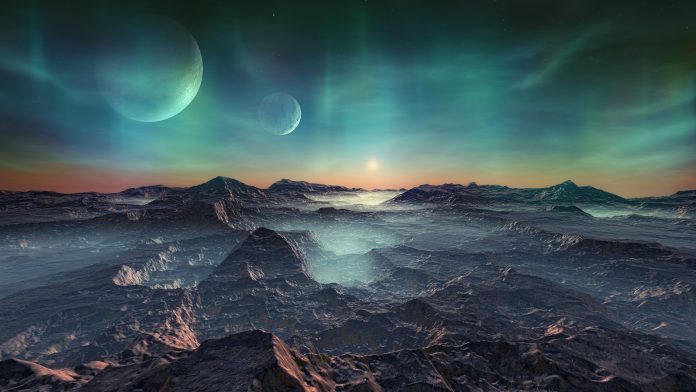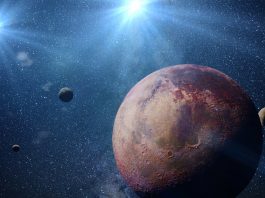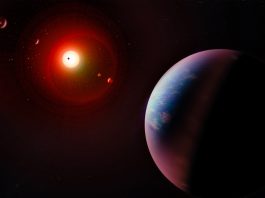Astronomers have discovered a rocky exoplanet using the European Southern Observatory’s Very Large Telescope (ESO’s VLT) in Chile.
Researchers have been observing exoplanets around L 98-59 – a nearby star – that bear a resemblance to those in the inner Solar System, shedding new light on the planets. The newly observed planets include a rocky exoplanet with just half the mass of Venus, making it the lightest exoplanet to be measured with the radial velocity technique.
This planet is possibly in the habitable zone, which has exciting implications: “The planet in the habitable zone may have an atmosphere that could protect and support life,” explained María Rosa Zapatero Osorio, an astronomer at the Centre for Astrobiology in Madrid, Spain, and one of the authors of the study published today in Astronomy & Astrophysics.
The quest to discover life on Earth-sized planets
The team’s findings present a significant step forward in the pursuit of finding life on planets a similar size to Earth outside of our Solar System.
The discovery of biosignatures on an exoplanet is reliant on being able to study its atmosphere, however, existing telescopes are not big enough to attain the resolution necessary to carry this out for small, rocky planets.
The recently observed planetary system, named L 98-59 after its star, is a promising target for future studies of exoplanet atmospheres. It orbits a star only 35 light-years away from Earth, and, as has now been revealed, it hosts rocky planets – similar to Earth or Venus – which are close enough to the star to be warm.
Searching for water on rocky exoplanets
With the help of ESO’s VLT, the researchers were able to deduce that three of the planets could contain water in their interiors or atmospheres. The two planets closest to the star in the L 98-59 system are most likely dry, but may contain small amounts of water, while up to 30% of the third planet’s mass could be water, making it an ocean world.
As well as this, the team discovered previously ‘hidden’ exoplanets that had not been spotted before in this planetary system. They found a fourth planet too, and believe there is a fifth, in a zone at the appropriate distance from the star for liquid water to exist on its surface.
“We have hints of the presence of a terrestrial planet in the habitable zone of this system,” said Olivier Demangeon, a researcher at the Instituto de Astrofísica e Ciências do Espaço, University of Porto in Portugal and lead author of the study.
This novel research signifies a technical breakthrough, as scientists – utilising the radial velocity method – were able to ascertain that the innermost planet in the system has just half the mass of Venus, making it the lightest exoplanet measured with this technique that analyses the wobble of the star instigated by the tiny gravitational tug of its orbiting planets.
The researchers employed the Echelle SPectrograph for Rocky Exoplanets and Stable Spectroscopic Observations (ESPRESSO) instrument on ESO’s VLT to study L 98-59.
“Without the precision and stability provided by ESPRESSO this measurement would have not been possible,” explained Zapatero Osorio. “This is a step forward in our ability to measure the masses of the smallest planets beyond the Solar System.”
In 2019, the astronomers spotted three of L 98-59’s planets for the first time, with the help of NASA’s Transiting Exoplanet Survey Satellite (TESS). This satellite relies on a method known as the transit method — where the dip in the light coming from the star caused by a planet passing in front of it is used to infer the properties of the planet — to search for the planets and measure their sizes.
However, it was only by including radial velocity measurements made with ESPRESSO and its predecessor, the High Accuracy Radial velocity Planet Searcher (HARPS) at the ESO La Silla 3.6-metre telescope, that Demangeon and his team were able to find extra planets and measure the masses and radii of the first three. “If we want to know what a planet is made of, the minimum that we need is its mass and its radius,” Demangeon said.
The researchers are hoping to carry on studying the system with the approaching collaborative NASA/ESA/CSA James Webb Space Telescope (JWST), while ESO’s Extremely Large Telescope (ELT), which is currently under construction in the Chilean Atacama Desert, is set to begin its observations in 2027 and will also be fantastic for further observation of these planets.
“The HIRES instrument on the ELT may have the power to study the atmospheres of some of the planets in the L 98-59 system, thus complementing the JWST from the ground,” added Zapatero Osorio.
“This system announces what is to come,” concluded Demangeon. “We, as a society, have been chasing terrestrial planets since the birth of astronomy, and now we are finally getting closer and closer to the detection of a terrestrial planet in the habitable zone of its star, of which we could study the atmosphere.”









